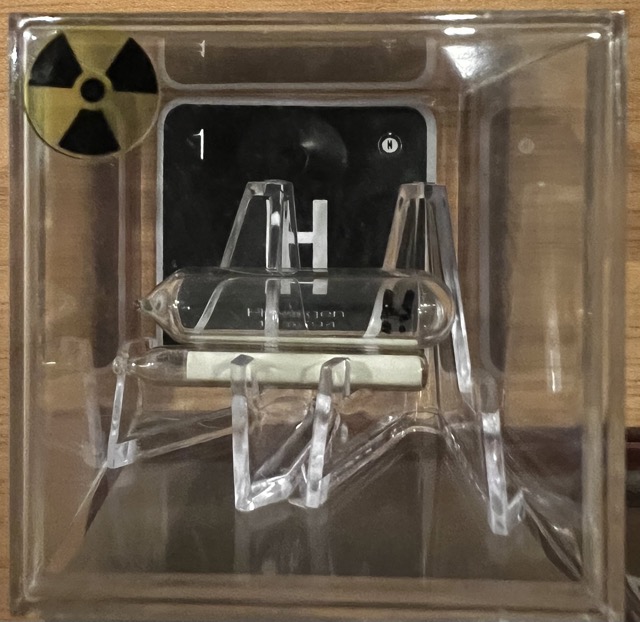Tritium
Atomic Number: 1
Atomic Mass: 3.01604928 u

Tritium, often symbolized as 3H or T, is a radioactive isotope of hydrogen. Unlike the most common hydrogen isotope, which has only one proton, tritium contains one proton and two neutrons in its nucleus, making it relatively heavy compared to normal hydrogen. Tritium is rare in nature, typically produced in small amounts through interactions between cosmic rays and atmospheric gases. It can also be manufactured in nuclear reactors and is a byproduct of nuclear weapon explosions.
Tritium is known for its low-energy beta decay, where it transforms into helium-3 with a half-life of about 12.3 years. This low-energy decay means tritium is not dangerous externally (its beta particles can’t penetrate human skin), but it can pose a health risk if ingested or inhaled. Tritium is used in various applications, including self-luminous aircraft and emergency exit signs, in which it is combined with phosphorescent materials to create a glow. It’s also used in scientific research, particularly in studies of chemical and biological processes, where it can serve as a radioactive tracer. Additionally, tritium has been considered as a fuel for nuclear fusion, potentially playing a role in future clean energy sources. The management of tritium is important, especially in nuclear facilities, due to its radioactive nature and the environmental and health considerations associated with it.
Uses
Tritium, a radioactive isotope of hydrogen, has several specialized applications, largely owing to its ability to emit low-energy beta radiation and its relatively short half-life of about 12.3 years. One of its most well-known uses is in self-illuminating devices. Tritium gas, when combined with phosphorescent materials, emits a continuous light. This property makes it valuable for creating emergency exit signs, aircraft dials, watches, compasses, and gun sights that can be seen in the dark without external power sources.
In scientific research, tritium is used as a radioactive tracer due to its chemical similarity to hydrogen. It can be incorporated into water molecules (as tritiated water) or organic compounds, allowing scientists to track biochemical processes, understand metabolic pathways, and study environmental phenomena such as groundwater movement.
Another significant application of tritium is in the field of nuclear fusion research. Tritium can be used as a fuel in fusion reactors, where it is combined with deuterium (another hydrogen isotope) to produce helium and energy, mimicking the energy generation process of stars. This potential use is particularly attractive for future clean energy solutions, as fusion generates less radioactive waste compared to fission and does not produce greenhouse gases.
Additionally, tritium is used in the calibration of geiger counters and other radiation detection equipment. Due to its predictable decay rate and specific type of radiation, it provides a consistent standard for ensuring these devices are accurate and reliable.
Despite its usefulness, the handling and disposal of tritium require caution due to its radioactivity. While it is not hazardous externally (its beta particles cannot penetrate human skin), it can pose internal health risks if ingested or inhaled. Therefore, its use is regulated and monitored to minimize any environmental or health impacts.
For Kids
- Glow in the Dark: Tritium is used to make things glow in the dark! It’s in some exit signs, watch hands, and gun sights. They don’t need batteries or electricity to glow, which is really cool and useful, especially in emergencies.
- A Special Kind of Hydrogen: Tritium is like a heavier cousin of the hydrogen we know, which is the lightest element. Hydrogen usually has just one proton, but tritium has one proton and two extra neutrons, making it heavier.
- Space Connection: Tritium is made naturally when cosmic rays from outer space hit the Earth’s atmosphere. That’s like a little bit of space right here on Earth!
- Super Rare: Tritium is pretty rare in nature. There’s not a lot of it just lying around, so scientists often make it in special machines called nuclear reactors.
- Safe Glow: The kind of radiation tritium gives off is very weak. It can’t go through the skin, so the way it’s used in glow-in-the-dark objects is safe.
- Water, but Different: Scientists can make “tritiated” water by replacing regular hydrogen with tritium. This special water is used in science experiments to learn more about how water moves through the environment and our bodies.
- Energy of the Future?: Tritium could be used for nuclear fusion, the same process that powers the sun. Scientists are studying this to see if it could be a clean energy source for the future.
- Half-Life: Tritium has a half-life of about 12.3 years. This means if you have some tritium, half of it will turn into something else (helium) in about 12 years. This is a bit like how food has an expiration date, but much, much longer!
- Stellar Birth: Tritium is also made in stars, like our sun, when they are forming. It’s part of the process that makes stars shine.
- Science Tool: In science, tritium is like a secret agent. It can be used to trace where things go in chemical reactions because it’s like regular hydrogen but with a special, detectable difference.
Remember, even though tritium is super interesting, it’s still a radioactive material, so it’s something that should only be handled by trained professionals in safe environments!
 using WordPress and
using WordPress and
No responses yet